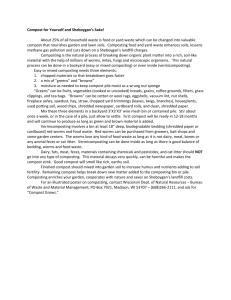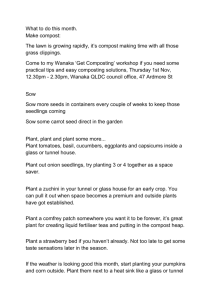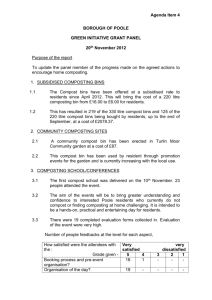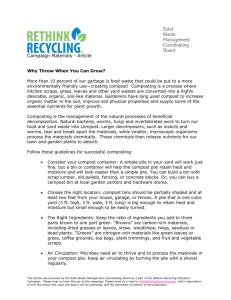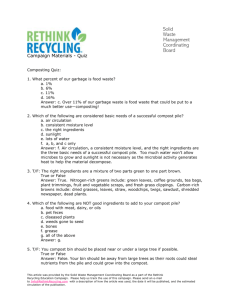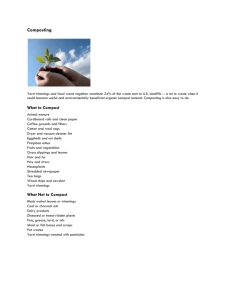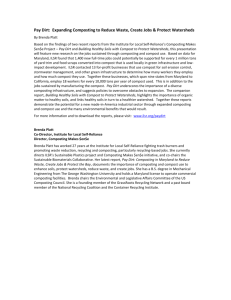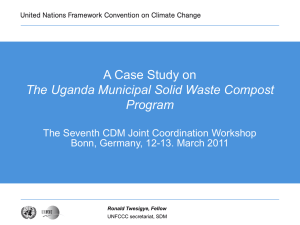On-Farm Composting - MAYTime Composting
advertisement
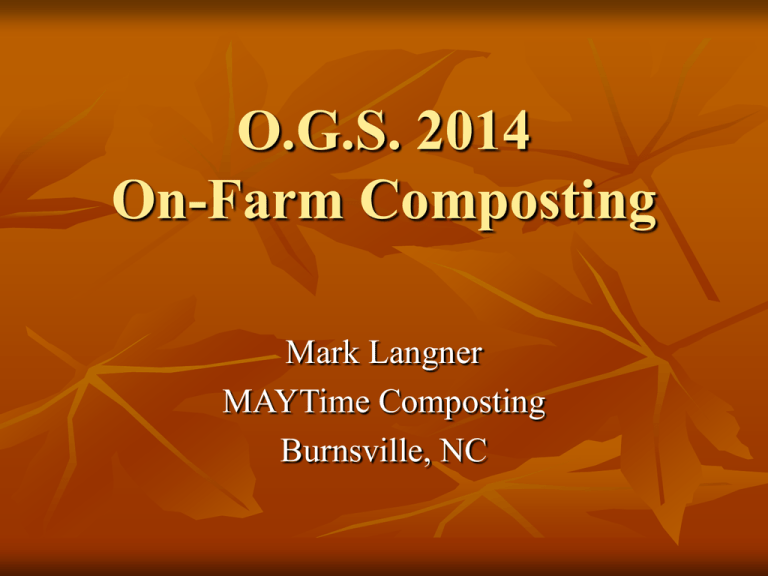
O.G.S. 2014 On-Farm Composting Mark Langner MAYTime Composting Burnsville, NC MAYTime Composting Mark Langner BA, Psychology; MA, Counseling. 25-year Career in Computers. Life-Long Gardener and Bad Composter. Then I Married A Horse Owner. Compost Bays, Worm Bins, Aerated Bays. Community Garden (2009). Owner and Founder, MAYTime Composting Systems, Burnsville NC. (2011) USCC Compost Operations Training (2011). What Is Compost? A Story… Compost is organic matter that has been decomposed and stabilized by bacterial and fungal processes, becoming a material that is beneficial to plant growth. (USCC Def.) Properly done, the composting process kills harmful organisms and weed seeds. A Diversity of LIFE – The “Soil Food Web”. What We’re Gonna Cover… Review the Basics And Some of the Complexities Some Legal Aspects (NC) Organic Standards Technology Resources NC: The Letter of the Law In NC: NO Permit Required For: (1) Backyard composting. (2) Farming operations and silvicultural operations where the compost is produced from materials grown on the owner's land and re-used on the owner's land or in his associated farming operations and not offered to the public. (3) Small Type 1 Facilities meeting [a list of] conditions. (Type 1 means you can compost yard, garden, and wood waste. ) NC: Law as Implemented Special Rules for “Urban Farms” and Community Gardens: Tier 1: No Imported Materials? No Permit Required Tier 2: Less Than 1 Cu Yd / Week Imported “Nitrogenous” Materials – No Permit Required Tier 3: 1 Cu / Yd or More Per Week – Demo Permit (Annual) Compost – Essential Ingredients For Good Compost Carbon (“Brown stuff”) “Available” Carbon vs. “Unavailable “ Nitrogen (“Green Stuff”) C and N in organic compounds! Oxygen H2O BALANCE! Carbon-Rich Materials Leaves – At Least Some! Sawdust, Wood Chips C:N Ratio Varies Widely Oak Leaves: 60:1 to 200:1 (depends on who you ask!) Maple Leaves: 30:1 – Ideal “As Is” Available C! – Particle Size and Surface Area. Straw, Corn Stalks Paper / Cardboard Nitrogen-Rich Materials Cow Manure Blood Meal Fresh Grass Clippings Horse Manure? Sheep? Llama? Goat? Some of These Are Closer to 30:1 Food Waste? Yes, BUT 90% Water. Balance! C:N Ratio Too much N? 20:1 to 40:1 “Ideal” is 30:1 Pile Can Overheat Smell of Ammonia – and Loss of N Not enough N? Cool Pile Longer to Break Down Balance! C:N of 30:1 – How Do You Know? NC Department of Agriculture Waste Analysis Report. Real-Life Example: Horse Stall Cleanout. Balance! Not Enough O2? Anaerobic Digestion Too Much O2? Produces Methane Does Not Heat Up Cools Down Pile Too Much H2O? Pile Becomes too Dense = Not Enough O2! Balance! Aim For 50-70% Moisture Content How do you know? “Squeeze Test”. Should Feel Like a Damp or Very Damp Sponge. Should Hold Together. A few drops of water? OK. Lots of water? Too wet. Other Measurements Bulk Density Target Range: 800 – 1200 lbs / cu yd. Too Dense? Can’t Get O2! High Tech Bulk Density Tester: 5-Gallon Bucket: Fill 1/3, Drop, Repeat Twice. Multiply Weight by 40. 20 – 30 Lbs = 800 – 1200 lbs / Cu.Yd. Other Measurements pH – Best is Near Neutral. High N Can Mean Low pH. Composting Process Tends to Bring pH Toward Neutral. Avoid Adding Wood Ash and Lime. Lime Causes N to be Released. Amend pH AFTER Compost is Finished. Putting it ALL Together: Balancing C:N, Density, H20, etc. SOP Method. Compost Calculators on the Web: www.klickitatcounty.org Green Mountain Technologies Composting Phases 1) Thermophilic. 131 F and Above 2) Mesophilic. 105-120 F Can Last 1-2 months 1-2 months 3) Curing / Ageing – Three to Six Months “Raw” Compost Can Have High Soluble Salt Content and “Burn” Plants. Target Temps Temperature Targets: 1) PFRP – Process to Further Reduce Pathogens (Thermophilic Phase) Windrows: 21 Days at 55C (131F) with Five Turnings Closed Vessels: 3 Days at 55C / 131F 2) Additional 14 days at 45C / 105F + Mesphilic Phase Organic Standards (USDA) Must Meet Temperature Requirements. Monitor Temps, O2 Levels, Times, H2O, etc. Other Testing Requirements for Stability, Contaminants, Pathogens. No Synthetics. “Hit List” of Forbidden Chemicals. Document: USDA NOP 5021 Composting Setups Simple Bin Simple Bin Windrows Aerated Static Pile Aerated Bay (Closed Vessel) Aerated Bay (Detail) Aerated Bay (Detail) Tiny Aerobic Digesters Potential Problems: Pile Does Not Heat Up Check Bulk Density Check Moisture Content Too Dry - OR Too Wet! C:N Ratio (Too Much C?). Potential Problems: Pile Overheats Temps Above 160F Kill Off Beneficial Bacteria Temps Above 170F Can Lead to Spontaneous Combustion (esp. in Large Piles) C:N Ratio: Too Much N? Aerated Piles: Increase Flow / Frequency of Aeration. Others: Turn! Potential Problems: Odors Odor Control Bury Odorous Materials ASAP. (This Also Helps Control Vectors.) Maintain O2 Levels. Weather: Don’t Turn Piles in Misty or Foggy Conditions (Mornings). Choose Your Site! 200+ Ft. From Dwellings. Other Equipment Screening Equipment. Remove Un-Composted Material (as in Wood Chips) Comes in Two Sizes: Tiny and Gigantic DIY Thermometer. O2 Gauge. Questions? WithCompost No Compost Resources Field Guide to On-Farm Composting (www.nraes.org) NCDENR USCC Copy of This Presentation: www.maytimecomposting.com\OGS.ppt


